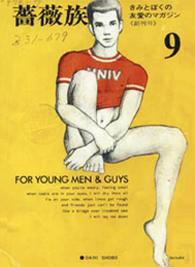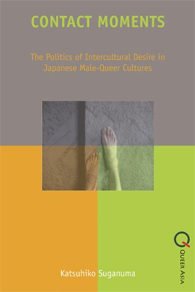Contact Moments: The Politics of Intercultural Desire in Japanese Male-Queer Cultures
By Katsuhiko Suganuma
The Ninth Volume in the Queer Asia Series Published by the Hong Kong University Press, 2012
I am having enormous pleasure reviewing the burgeoning Queer Asia series by Hong Kong University Press. As a non-academic reader, I find that one can often lack the keys to open doors to current scholarship in the hugely diverse field of Asian sexualities and genders. This series is going further and further in providing this missing access. Works so far published in the series have focussed on China, Hong Kong, Indonesia, the Philippines, Taiwan and Thailand (I’ve missed the eighth work published so far, Denise Tse-Shang Tang’s Conditional Spaces: Hong Kong Lesbian Desires and Everyday Life, but will chase it up and write about it soon).
Now, Hong Kong University Press has given Japanese (but in part American and Australian educated) scholar Katsuhiko Suganuma, Assistant Professor at the Center for International Education and Research at Oita University, space to turn our attention to Japan, and in particular to one aspect of its relations with the West, masculine same-sex desire.
Suganuma makes it clear on his first page that his recently published Contact Moments is not so much about Japan’s ‘queer cultures’ themselves but about their relations with the outside world and in particular with America. As he puts it: “This book looks at how binaries are used and employed in the context of contacts between queer cultures in Japan and the West (Euro-America)”, the binaries at issue being “concepts including ‘us’ and ‘them’, ‘West’ and ‘non-West’, ‘man’ and ‘woman’, ‘heterosexual’ and ‘homosexual’.” Later, he sets himself to answer the questions: “What does cross-cultural contact do to Japan’s construction of gender and sexuality? How does the discourse of gender and sexuality mediate national politics in the context of globalisation? And how and in what ways does the binary opposition of local/global, Japan/West, and us/them, reconstitute itself through being deployed at the moment of queer cross-cultural contact?” In effect, how has the West affected Japan’s queer culture over the last seven decades?

His analysis centres around key texts, organisations and individuals in an ascending chronological framework which is not, and is not intended to be, a history of gay Japan. I should say at the outset that these analyses are by their nature exemplars only, designed to illustrate the bigger picture he senses behind them. Suganuma draws conclusions from, and posits wider application by, these examples, but does not claim to be analysing developments seen across the whole of this historical period. He starts with the same-sex element of the ‘upsurge of discourses on gender and sexuality in early post-war Japan’, that is the nikutai bingaku (‘literature of the flesh’) which emerged as part of the post-war kasutori commercial sex culture, particularly in the hentai zasshi (‘perverse magazines’), which carried discussions of the sex provided to American conquerors by the commercial pan pan boys. He then moves on two to three decades to the seventies and examines Japan’s first commercial gay magazine, Barazoku (Rose Tribe), and the light it reflects on Japan’s gaijin (foreigner) complex, looking in particular at the magazine’s vivid images of Japanese men as small, effeminate and vulnerable children threatened by large, hairy and predatory Westerners.
Chapter 4 of the book is a reflection upon Japan as it was seen in the nineties by a Caucasian American, John Whittier Treat, who wrote of his experiences teaching there in his memoir of 1999, Great Mirrors Shattered; Homosexuality, Orientalism, and Japan. Treat was an intelligent man who pondered on all the issues involved in the cross-cultural sexual transactions in which he indulged. Many have seen him as an unreconstructed Orientalist or even racist, but Suganuma is kinder and finds an irony in his work which he considers aimed at undermining the very stance of which Treat is accused.
Suganuma then moves on but remains in the nineties to examine the politics of what he describes as the ‘mask’ of western activism adopted by the Japanese LGBT activist group OCCUR, the Japan Association for the Lesbian & Gay Movement, which was founded in 1987. Finally, he addresses the web site Gay Japan News (GJN), established in 2007 by Mochizuki Hiroshi and his American male partner to bring to Japanese netizens LGBT news from around the world.
This is a densely written volume in typical Queer Theory style, and if it has a fault it is that it is too introverted in the way it gives such wide space to discussions of Queer Theorists and their pronouncements. These tend to swamp the text and detract from what the writer is trying to say. One comes to wish that he (like many other academics of the genre) would have a little more courage in his own convictions and less in those of Foucault, Judith Butler or Eve Kosofsky Sedgwick. The discipline of Queer Theory is so difficult to like that one finds oneself persevering only because the intrinsically fascinating subjects of which it treats make the mental masochism of reading its texts worth the pain.
Suganuma himself seems to wonder if it’s all worthwhile. Using a horrible ‘Orientalist’ cliché, Suganuma is too inscrutable to completely cut the ground from under his own feet here, and so at times seems to float on a mist of unknowing. In his conclusion he worries about Queer Theory’s faults: its deconstruction of categories without any useful replacement; its highly theoretical methodology; it’s a-historical analysis; its dissociation ‘from the everyday social and political conditions facing LGBT individuals’; its over-emphasis on surfaces rather than interior psychologies. Elsewhere he frets that Queer Theory has loosened too far the boundaries of what it addresses; can it be said to be studying anything concrete at all if everything is ‘queer’? Does the whole discipline of Queer Studies not suffer from overmuch concentration upon post-colonialism, which by battling the ‘Orientalism’ inherent in the Western perspective perpetuates its influence in the guise of the ‘other’ or ‘enemy’. Suganuma is not adamant about it, but I think he thinks so.
One could personally add to his list of Queer Theory downers the perpetual mangling of the language in the ever more elaborate neologisms its writers employ and in their often garbled syntax, which evaporates meaning as it seeks to impress. Suganuma is not entirely innocent here himself. The odd use of ‘interpellated’ or ‘interpellation’ might be excusable, but six times on one page (73)? I looked it up in the Oxford English Dictionary only to become less wise than before.
Do these studies allow Suganuma to answer the questions he poses in his introductory first chapter? I would have to respond only ‘to some degree’, and it would seem that his answer to the question of whether foreign contact has affected Japanese queer culture is similarly ‘to some degree’. He does not, I think, believe that the binary of ‘local’ / ’foreign’ can be said to define Japanese culture. What, then, are his conclusions? Japanese ‘referencing of the West resulted in moments in which the Japanese subject became more conscious about personal identities and images.’ The binary was thus ‘generative and productive.’ This is not a very concrete conclusion, though it is an honest one. Maybe it is doubtful, he finally muses, if looking at Japanese culture through the prism of ‘the binary’ of its relationship with the West is a good idea at all. Can Japanese queer culture not stand alone? Suganuma seems to think so, but he is not categoric on the point. It is a conclusion, though, that I have found grows more and more compelling from a reading the whole Queer Asia series and it is one I have come personally to support.

